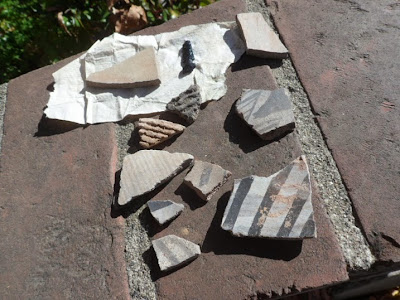We collected pottery shards and related debris. I always wanted to find someone who might have a better understanding of what we were looking at. I wondered whether the first site was a remnant of the Piro Indians, who were once common in the Socorro area.
There was an interesting recent article in New Mexico Historical Review ("The First Province of that Kingdom": Notes on the Colonial History of the Piro Area) written by Michael Bletzer, whose specialty is the archaeology of Piro Indian ruins in Socorro. It sounded like he might be the guy to contact.
Bletzer looked at my photos of pottery shards and thinks they are older than what he was looking at near Socorro: pre-1300, for sure.
I thought it was an interesting exchange (enclosed below):
Dear Mr. Bletzer:He replied:
I read with interest your article on the Piros in NMHR, and was curious whether you had any information regarding (the ruins at site 1). Do they date from the chaotic times of the 1690's, or are they older?
Hello,I replied:
The main structures at (Socorro) appear to be much older than the Revolt Period. Some of the ceramics indicate at least a 14th-century occupation. Doubtless, however, the area was used until the abandonment, in 1680, of Pilabo/Socorro Pueblo.
There are also scattered about the foothills small sites with slag, 17th-century ceramics, and Spanish artifacts, which indicate prospecting by the Spanish. Nothing big came of this; there was never any large-scale mining during the colonial period.
Regards,
Michael
Thanks, Michael!
It's fun revisiting memories of when I was a freshman at NM Tech (1974-1976).
I'm attaching a few photos of some of the stuff we gathered (at Site 1).
Take a look at the ceramic fragments picture and see if you can make anything from them.
The ruins of these structures seemed strange to me. They didn't look like Puebloan structures, and so I thought maybe they were seasonal shelters of some sort, whether by Piro Indians, or others.
We also visited another interesting site (Site 2). An arroyo was actively eating through what had been a buried pit. It was a perfect, pre-cut profile, custom-made for the archaeologist in mind, but unfortunately it was in the process of being destroyed by the arroyo. Who knows how much of it lingers? There was also ruins of a European house on a nearby hilltop there.
He replied:
The trouble with archaeology, of course, is that there is so much work to do, and the ruins are so vulnerable to damage.
Meanwhile, to learn more about the later history of the area, I'm starting to read more about the consolidation of Comanche power in the mid-18th Century, and their explusion of the Apache, which hit Spanish colonial New Mexico so very, very hard.
Hello Marc,And indeed, he rendered a verdict:
It seems I misread your original question - somehow I was thinking of (another location) - an interesting site in itself but not the one you are referring to.
Now, the site you actually describe I haven't seen. I'll look at the ceramics and let you know what I think (whatever that may be worth, haha...)
Regards,
Michael
Marc,That's great!
As far as I can tell from the photos, your ceramics are old, pre-1300s definitely. Older by at least 200 years than most of the glazewares I'm dealing with on the sites I'm working on around Socorro.
(Regarding site 2) I did a site inventory with some colleagues, but other than limited survey no work has ever been done on any of those sites. They are out in the middle of nowhere, very cool locations! No wonder people are seeing aliens down there....
Cheers,
Michael
The trouble with archaeology, of course, is that there is so much work to do, and the ruins are so vulnerable to damage.
Meanwhile, to learn more about the later history of the area, I'm starting to read more about the consolidation of Comanche power in the mid-18th Century, and their explusion of the Apache, which hit Spanish colonial New Mexico so very, very hard.




No comments:
Post a Comment